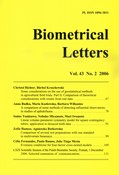
Biometrical Letters vol. 43(2), 2006, pp.67-77


For the description of spatial dependency, the spherical model and the exponential model - both developed for point data - are often utilized. Using both as initial models for different regularizations (transects, plots), we examined the behaviour of the corresponding covariance functions by means of simulation (Richter and Kroschewski, 2006). Now, the theoretical considerations are confronted with results from two uniformity trials. In the first trial, the spatial dependency of single plants was observed. Only by the summarizing of plants to small plots and by the superimposition of environmental effects do there appear covariances which could be modelled by the above-mentioned standard models. In the second trial, larger plots were derived from the small plots and covariance models were fitted. We used the SAS procedure MIXED with all available spatial variance-covariance structures. Using the Akaike criterion, the covariogram functions show mostly anisotropy and a sigmoid shape. Their nugget variance decreases with increasing plot size and/or plant density. So far, the theoretical considerations seem to be confirmed. However, the sensitive estimation of the range does not reflect the theoretical results. Further investigations, taking into account crop, soil and weather-dependent results, are necessary.

geostatistical methods, point data, regularized data, agricultural field trials

